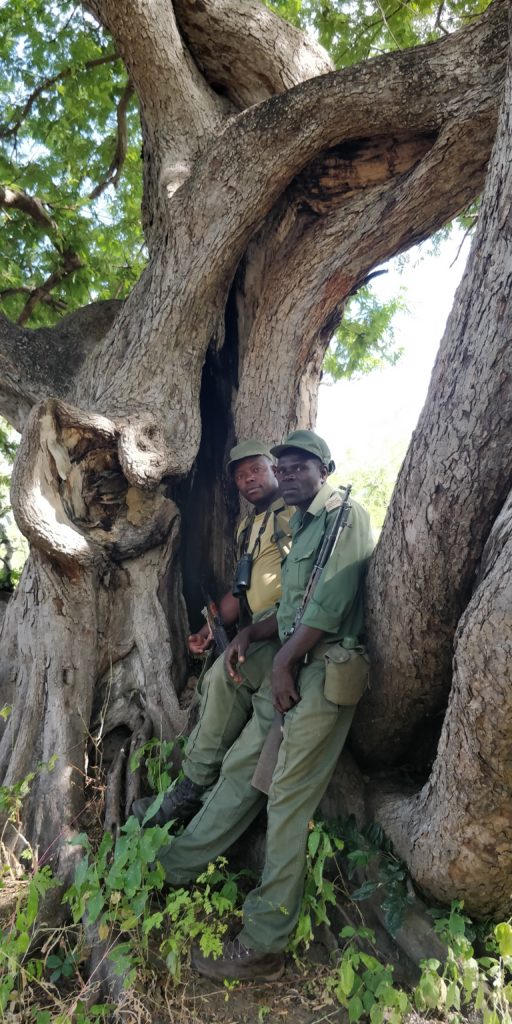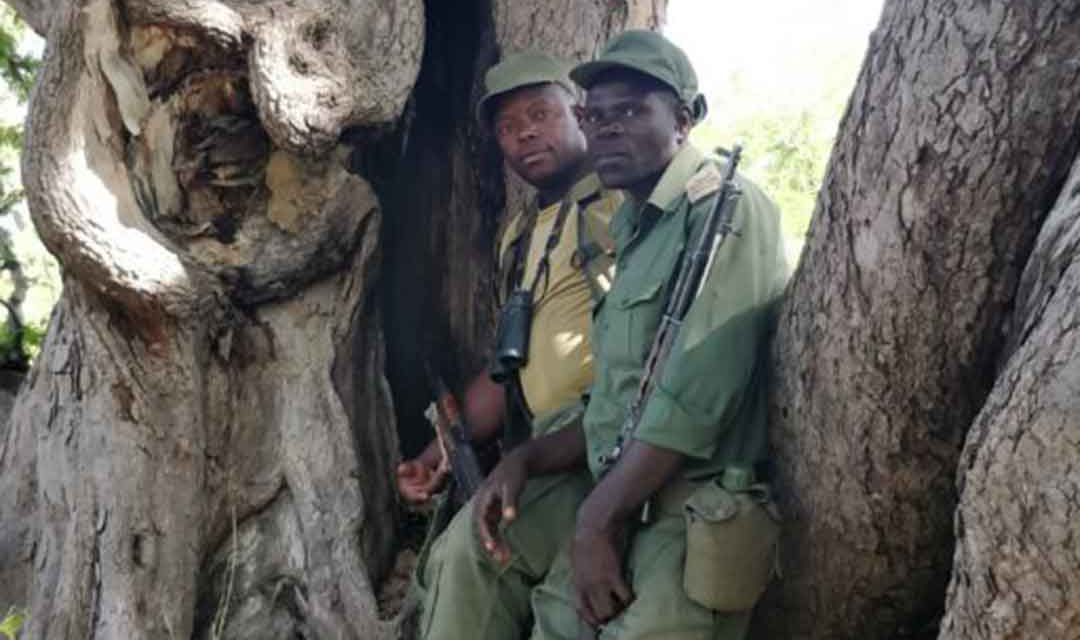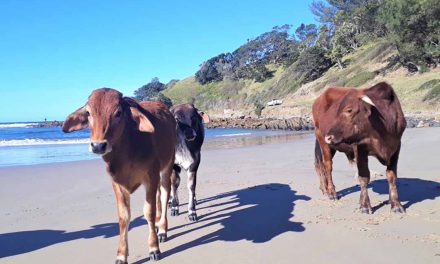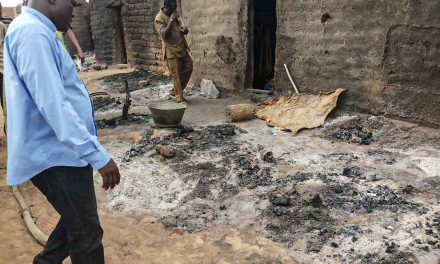African conservation: a wake-up call
Fixed and polarised attitudes to African conservation remain a major impediment to robust, solution-seeking debate

Park rangers in Zimbabwe
Photo: Richard Maasdorp
A lifetime of wild experiences in the Zambezi Valley and a decade at the helm of The Zambezi Society – which practises a no-nonsense, hands on, practical approach to protecting this magnificent wilderness area – has given me many opportunities to reflect on the realities of conservation in Africa.
We are in danger of becoming bogged down in conventional and conservative thought. The current COVID-19 crisis brings this into sharp focus. Our worlds may have shrunk temporarily, and our activities, too, but we must not lose sight of the broader vision that gave birth to our commitment in the first place. I think it’s time we opened our eyes to reality. We need to stop thinking about Africa’s conservation problems in generic terms. Many opinion leaders, international conservation organisations and media tend to see Africa’s conservation challenges as generic.
This leads them to suggest “one-size-fits-all” solutions that lack relevant local context. The results may produce inappropriate interventions, ill- advised lobbying and funding channelled into initiatives that, while they might work in one place, may be totally ineffective, even destructive, in others. From a platform of research, professionalism and transparency, Africa needs to continue to challenge the idea that international organisations or donors have solutions to the continent’s conservation problems that are in some way superior to our own.
That these internationals have political clout and financial resources does not mean they can solve our problems. Take elephants, for example: some African countries have either lost or are losing their elephant populations at an alarming rate. Others have stable populations. But the individual circumstances that led to the latter are not discussed. Botswana and Zimbabwe together are custodians of more than half the population of African elephant.
In East Africa, over decades, elephant populations declined dramatically due to illegal activity, habitat loss and human encroachment. The conservation voices of these countries demonised traditional elephant management techniques such as hunting (even in marginalised habitats), or wildlife population control and preached that photographic tourism, conservation outfits and government could provide all the solutions. Their generic message has become “gospel” for elephant conservation models across the world.
But in southern African countries – notably Botswana, Zimbabwe, Zambia and Namibia – hunting and wildlife population control measures have, for decades, been incorporated into a range of conservation policies aimed at discouraging illegal activity, human encroachment and habitat loss. The elephant populations of these countries remain relatively healthy – a story not often told. Yet, international pressure for southern Africa to adopt the all- purpose “East African” conservation model is great.
Even within a country, the contexts are varied. In Zimbabwe, for instance, there are four distinct elephant sub-populations – each with a different problem requiring a customised management solution. With such varying situations, a buffet of management solutions is required. Each of these four separate areas in Zimbabwe now has their own customised Elephant Management Plan devised by the Zimbabwe Parks and Wildlife Management Authority (ZPWMA) and a group of stakeholders and is subject to regular review and update.
When I first entered the conservation arena in Zimbabwe, I was shocked by the bloodletting between the players, driven by egos and the perception that funding is a scarce resource. Even in my former life in the construction industry, we had a collaborative umbrella organisation to take care of the industry as a whole. This allowed for robust debate, and gave us a platform from which to lobby for enlightened policies on which we could stand together against unfair or inappropriate practices emanating from new international players.
But Zimbabwe’s conservation “industry” has no such platform at a national level. A newly-developing collaborative effort in the Lower Zambezi Valley area is making some progress. But the future of the wildlife spaces that conservation bodies purport to protect is most often at the mercy of the loudest, most influential, monied or most connected voices. These are not necessarily the most constructive or sensible. My participation at the African Conservation Lab in 2017 in South Africa did little to reassure me that this problem is confined to my own country.
Fragmentation and rivalry in the conservation arena appears to be a common problem across other elephant range states. National conservation vision and strategy is not crafted by a collective of informed and pragmatic stakeholders (Zimbabwe’s Elephant Management Plans are laudable exceptions – with the Lower Zambezi Valley’s collaborative and dynamic one often now acknowledged as a game changer that works).
Individual activities that support wildlife spaces and are having a positive impact most often lack synergies and are missing out on optimisation possibilities. The embryonic Lower Zambezi Valley collaboration model is an exception (although even this has its mavericks), and has demonstrated that significant results can be achieved with effective collaboration. Donor organisations, with a few exceptions, also do not often collaborate with each other. Funds are committed to fragmented initiatives. Donors, often driven by their own priorities or their reading of country politics, tend to withhold funding or are skewed towards activities that may be inappropriate.
Elephants cannot vote. Local conservation organisations are often “muscled out” by international and regional entities or tourism operations that have the money and connections. In this way, a country becomes vulnerable to economic “recolonisation”. However, a collaborative approach that seeks genuine engagement with local stakeholders can harness latent potential that exists amongst a country’s citizens and its own biodiversity resources.
Similarly, without engaging local stakeholders to provide carefully channelled funding mechanisms, opportunities to build strong, long-term, impactful partnerships with the local regulatory authorities and other sectors (e.g. tourism, agriculture/tobacco-growing, hunting, communities, schools, etc) and to improve their effectiveness, are missed. Local conservation organisations are forced to march to the tune of international regulatory outfits such as CITES and larger international funders such as USFWS and GEF. These entities often have their own internationally-based lead managers who would do better if they collaborated with local stakeholders.
There are several “community myths” that are problematic, too. The first is that “Unless the buffer zone community is persuaded into conservation by reaping the benefits of it, we will lose the battle to protect these areas”. But we do not say… “Unless the neighbours to this bank/service station/commercial farm receive direct benefits from this business, it will fail”. Another myth is that tourism can help communities surrounding protected areas. The reality is that the margins in tourism are not great enough to save a community from poverty. It is also claimed that job creation in the buffer zones around wildlife spaces will alleviate the poaching problem.
In fact, young people in the main want jobs in the cities, not handouts or meagre pickings on offer in a marginal area. The reality is that we need an alternative means of tackling the “communities versus wildlife” issue; piecemeal inducements for conservation or handouts from a fickle tourism industry aren’t enough. Rural farmers will always see wild animals as a threat to their crops. Tourism revenue is unreliable and can cease altogether as a result of political unrest, natural disaster or pandemic. Meaningful jobs for rural people can be created. An example is the My Trees Project in the Zambezi Valley, which seeks to become a major employer of women in buffer- zone areas to replant and become guardians of indigenous forests by harnessing green climate funds or carbon credits.
But, frankly, this won’t satisfy the young. What the conservation industry really needs to do is pressure governments to put the cities to rights so that they can create and provide the jobs the rural young need. Better still, this industry should contribute to fixing the cities themselves (a 10 to 20 year journey if professional, public-private sector boards/ commissions collaborate to run them, not party-political councillors, as they often are in Africa).
Conservation is still tainted by a “greenie” image. It needs to become an industry in its own right (and be recognised as such), albeit with some philanthropic support towards not-for-profit outcomes, and become a tangible contributor to the economy, the service sector, and the manufacturing sector. It needs to become known for its job creation at a national level, as is the case in Kenya. I have been in the unique position of “working” between the bush and the boardroom. I spend days out on deployment with rangers and understand their intrinsic value beyond their technical roles.
My most powerful insight has been that the conservation quest has been led, over the generations, by qualified conservationists (often pockets of ego-driven passion) and bureaucrats (regulatory personnel). What is lacking is holistic visioning, trans-sector thinking and commercial aptitude. A top-down management approach is out of place in the modern world. A level-one park ranger has valuable opinion! We need to move towards an enlightened leadership, vision-and-execution approach, so we can forge the links between the global desire to protect wilderness, the rangers on the ground and the wildlife under their stewardship.
Governments need to ensure that they place the value of wild land and its wildlife on their balance sheets – a value on par with the national power utility may result. This is particularly true in Zimbabwe, where a commendable 13% of
the country is legislated as wildlife estate (and a similar percentage under private custodianship), and would reinforce the bid for it to be managed accordingly.
In an increasingly developed world, the value of wilderness areas as places for spiritual and physical healing (for those who can afford it) is underestimated. But to expect African governments to fully fund these global wilderness gems shows a poverty of thought and understanding. Africa’s governments may never be able to prioritise conservation above health, education or military expenditure. Hence, there will always be a funding gap, which if not met (transparently) will result in globally important wild spaces eroded rapidly and irrevocably.
It is also risky to rely on tourism income to save wild places. Not all wildernesses are suitable for tourism. Indeed, some 70% of the impressive 13% of land area set aside for wildlife in Zimbabwe is too rugged and hostile for traditional tourism. But it is still in need of custodianship.
Even wild places popular for tourism are vulnerable to a crisis situation – as the current coronavirus outbreak demonstrates. It may take more than a decade for these destinations to recover from the setback. What future do wild spaces dependent on tourism now face? The world has a responsibility to assist the conservation of these wild spaces, with funding support and the provision of appropriate expertise, relying on local accountability and capacity.
We need to bring the best minds and hearts to the conservation debate. Those with disguised motives should excuse themselves. We need robust discussion resulting in yet unimagined outcomes. We need to listen. Fixed and polarised attitudes remain a major impediment to robust, solution-seeking debate. The elephant issue is not about elephants across Africa or an individual elephant or its family (an unhelpful animal welfare narrative )); it is about finding the most suitable ways to conserve discrete populations in their distinct wilderness landscapes.
There is a global responsibility to fund, resource and upskill each of these wilderness landscapes. I encourage Africa’s conservation visionaries to use the mind space created by COVID-19 to shift out of the rut of present “looking- forward” dogma, and imagine beyond a 10-year horizon with a “future-looking- back” approach. There isn’t a one-size-fits-all solution to conservation problems in Africa. Individuals, NGOs, governments and donors all need to understand this, and to respect that diverse situations require their own unique solutions.
Richard Maasdorp has a deep love for the people, the wildlife and the wild places of Zimbabwe, his country of birth. A retired civil engineer, he has a Masters in Business Leadership and a wealth of experience as head of several major construction companies, and chair of Zimbabwe’s power generation board. A patient and passionate observer of nature, he now leads The Zambezi Society, helping to conserve the Zambezi River’s magnificent wildlife and wildernesses.














Excellent article. The author has identified the full set of complexities, wishful thinking, inadequate analyses and blinkered vision that marks conservation approaches in Africa. To be sure, Zimbabwe has a more realistic and intelligent conservation history than most, largely through promoting a community-based approach to natural resource management, or CBNRM. Having worked in Zimbabwe – and conservation – for many years, I have witnessed the slow birth and emergence of CBNRM as policy and practice, and it is clear that it is making inroads into ‘fortress conservation’ across Africa. But there is much to be done. Conservation must be integral to our education systems, to the economies of Africa and it must start at the human-wildlife interface. This means recognizing that rural communities are at the coalface, so to speak, and their experience and understanding must be incorporated into conservation policy. They must be seen not just as potential ‘rangers’, but as custodians. Big difference.
Hi Julian,
Many thanks for your response and your support. Kindly keep an eye on our page for more*
Thank you for your writing. This needs to be distributed more widely and Ill try to help do that.
Hi Kim,
Many thanks for your support and positive response. Kindly keep an eye on our page for more*